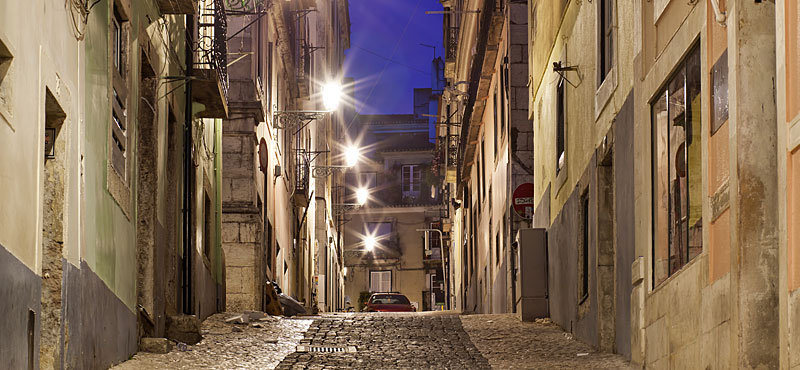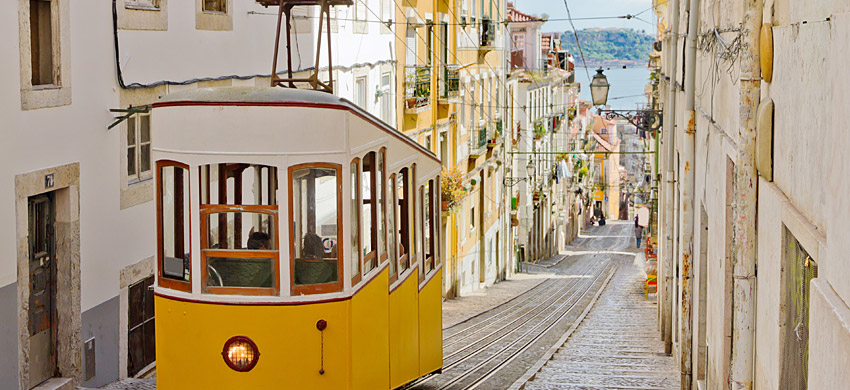

Famous for being the heart of the nightlife of Lisbon, Bairro Alto is a district full of history; it was originally inhabited by the Lisbonian aristocracy and after the earthquake it became a popular area featuring several workshops, shops, and newspapers headquarters.
Just like the Alfama district, it is located on a hill dominating the Baixa; however, this is the only characteristic that these two districts have in common. If the first district is a chaotic mix of alleys and squares, the Barrio Alto is characterized by an orthogonal structure with parallel and perpendicular streets. Strolling around the area during the day or at night will give you two completely different feelings.
Its past made of noble elegance and popular vivacity has created a fertile soil for shaping a creative movement that, in the last few years, has given birth to numerous art galleries, boutiques, artists workshops, and design shops.
Stroll around the district, pay attention to the facade of the buildings covered with street art. If you are tired, enjoy some rest at one of the many gardens of the district, and enjoy the view over the city.
At night the young locals go to Barrio Alto to enjoy a few drinks until late at night.
This is the magic of Barrio Alto, this area wrapped in shabby-chic style where it is possible to listen to fado and hard rock music at the same time; an area loved by students, elders, hipsters, gay community, party animals, and all kind of people.
The district is full of attractions; a guided tour will help you discovering all the secrets of Barrio Alto and live just like a local.

A city characterized by steep ups and downs like Lisbon could be a real nightmare for locals and tourists; luckily there are the “elevadores”, that is to say lifts and elevators that allow to move effortlessly around the city.
There are four famous elevators in Lisbon, and two of them are connected to Barrio Alto:
The coaches of both Barrio Alto’s funiculars are those traditional white and yellow trains that are usually portrayed in the postcards of Lisbon.

Built in 1533, the Church of São Roque is the earliest Jesuit religious building within the city of Lisbon. Its austere facade is not very inviting, but its interiors are a triumph of marbles, golden stucco, paintings, and azulejos, colorful and traditional Portuguese tiles.
Do not miss a visit to the Chapel of St. John the Baptist, which was designed and constructed in Rome and then it was disassembled, shipped, and reconstructed in Lisbon.
The panoramic terrace of San Pedro de Alcantara is one of the most famous and biggest viewpoints of Lisbon; from here it is possible to admire the Baixa, with a stunning view over the Castle and the Cathedral. To find out the most interesting sites visible from the miradouro, check the panel decorated with azulejos located on the balustrade.
Founded in the 19th century, the garden of the miradouro and its benches, trees, and a lovely fountain is a great place where to take a break. Take a look at the bust sculptures representing mythological heroes and Portuguese characters including Edoardo Coelho, founder of the national newspaper “Diãrio das Notícias”.
Featuring about 2500 spices, the botanic garden of Lisbon is considered one of the most important gardens of Europe. It is located on a panoramic position and it is a great place to enjoy a break and some shadows, walking along the alleys filled with palms, banana plants and conifers.
The Church of Sao Roque and the tram 28 are just some of the attractions included in the Lisboa Card, the tourist card of Lisbon that allows unlimited use of public transports (including the tram) and discounted or free entrance to the most famous museums and monuments .
If you are planning to visit many museums and monuments and to move by public transports, the Lisboa Card is always the most convenient solution.
Barrio Alto is famous for its numerous bars, pubs, and clubs located around the district. Young locals hang out here at night to have a drink with their friends, hopping from bar to bar.
The variety of places in the Barrio Altro district is really impressive: in just one night you can drink a frozen beer in a tiny pub with rock music, a cocktail in a fancy bar, a glass of Portuguese bar in a traditional “tasca”, or taste a real Cuban mojito.
Follow the locals, take a glass and go out to experience the Portuguese movida along with the people of Barrio Alto.
The streets where you will find more bars are Rua do Diario de Noticias and the streets taking to Chiado, in particular Rua da Rosa, Rua da Misericordia, Rua Dom Pedro V and Praca dos Camoes.
Barrio Alto is one of the central districts of Lisbon, and you can easily walk there from Chado. Another and more charming way to reach it is by taking the historical tram 28 which routes through this district; another option is to take Avenida a Libertade through the Elevador da Gloria.
To see all the facilities and book accommodation in Bairro Alto use the form below, entering the dates of your stay.
City Card allow you to save on public transport and / or on the entrances to the main tourist attractions.
